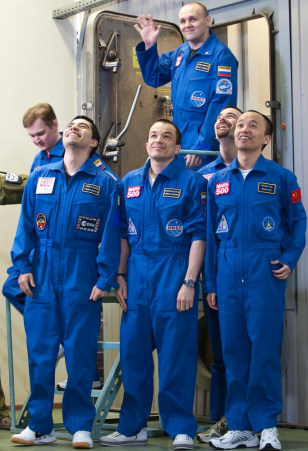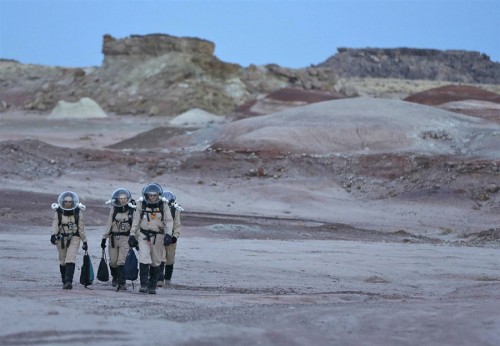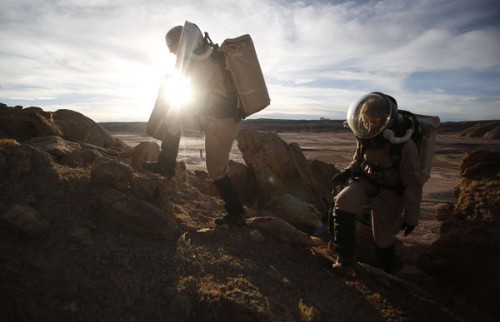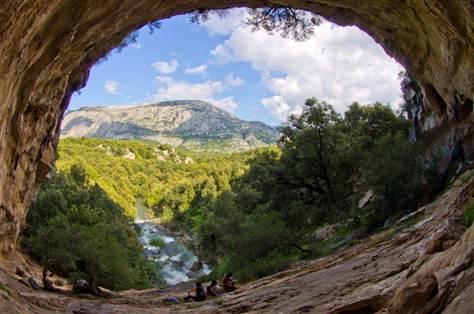You may have gotten a chuckle about the first manned mission to Mars, but millions of dollars have been spent all over Earth in the last decade, researching how man will survive physically and mentally in the inhospitable environment.
 Last year in Russia a worldly crew consisting of three Russians, a Frenchman, an Italian-Columbian and a Chinese citizen survived exhausted but in good spirits after being encased in a windowless module for 520 days, to simulate a flight mission to Mars. The experiment cost $15 million and was the longest to date as part of the Mars-500 studies in psychosocial isolation, which have been being conducted since 2007.
Last year in Russia a worldly crew consisting of three Russians, a Frenchman, an Italian-Columbian and a Chinese citizen survived exhausted but in good spirits after being encased in a windowless module for 520 days, to simulate a flight mission to Mars. The experiment cost $15 million and was the longest to date as part of the Mars-500 studies in psychosocial isolation, which have been being conducted since 2007.
In the United States a non-profit organization called The Mars Society built the Mars Desert Research Station in Utah, which has housed 126 crews since 2002. These crews study the geology of the surrounding area in full gear, much like what scientists in the future will do on Mars. One volunteer, Jim Urquhart, is a photographer who documented his experience with beautiful photography in his blog.
In the Canadian Arctic, researchers have been simulating Mars missions in the 12-mile wide Haugton Crater for the last 14 years with the Haughton-Mars Project. Pascal Lee, the project’s creator and director, likens the missions to a game of “Survivor”, played on a pretend Mars. Examples of the things they test include drilling the frozen ground for biological samples and treating the nutrient-poor soil to make it fit for growing food.
Even caves have been used to help simulate conditions of planet exploration. In 2011 a group of astronauts explored unmapped areas of a cave system in Italy for six days, in an experiment to study working together in a potentially dangerous environment. In the dark, with no one but each other for problem-solving, the team had to navigate through dangerous terrain, including underground lakes, and make such decisions as whether to split up or stay together. Even after only six days in an alien environment, the team was struck by the smells and colors of the Earth’s surface once they returned.
Today, in the Hawaii Space Exploration Analog and Simulation (HI-SEAS) experiment, six non-astronauts are a month into a four month study funded by NASA to explore what foods will be sent to Mars with astronauts. The crew is also testing anti-microbial underwear, and one member is conducting studies to determine whether a robotic pet would better serve a crew with a needy, assertive or passive “personality”. When the crew goes outside, they must suit up, and soon the experiment will include communications “to and from Earth” having a 20 minute delay to simulate communications travel time between Mars and Earth.
or passive “personality”. When the crew goes outside, they must suit up, and soon the experiment will include communications “to and from Earth” having a 20 minute delay to simulate communications travel time between Mars and Earth.
So if our first trip to Mars leaves you with humorous visions of a man and wife hurtling through space at each others’ throats, protected from dangerous rays by their own fecal matter and entertaining themselves by torturing their robo-cat with a laser light, know that many people are taking it very seriously.
We are going to Mars, and there is no shortage of people willing to go to all lengths to make sure we are well-prepared to make it happen.
Sources: NBCnews, photoblog.nbcnews.com, Space on NBCnews (See links in story for more information)



